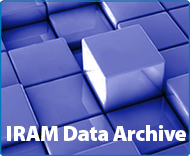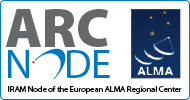News
IRAM opens a new spectral window on the Universe
The spectral range from 71 to 80 GHz is of fundamental importance for a number of questions in the extragalactic and galactic research areas but, despite of this, is one of the few spectral windows that remained inaccessible to interferometers. While the IRAM 30m telescope started in the winter semester 2015/2016, after the EMIR upgrade, offering the possibility to observe in this spectral window, the NOEMA interferometer is gearing up to provide in the winter semester 2016/2017 the first-ever opportunity to perform synthesis mapping observations in the 75 to 80 GHz window, and in the summer semester 2017 observations down to 71 GHz. No other interferometer will be covering this frequency range in the next years.
The combination of NOEMA and the IRAM 30m telescope will offer unprecedented opportunities for new discoveries in the 71 to 80 GHz window over a large range of spatial scales. Furthermore, the frequency-agility, calibration-precision and excellent sensitivity of the two observatories will be the only ones of their kind to perform deep molecular and atomic line imaging surveys in the extragalactic and galactic domains.
In recent years, the capabilities and sensitivities of the IRAM facilities in producing deep blind redshift surveys, breaking redshift degeneracies and building up CO spectral line energy distributions have been key in improving our understanding of star formation in the early Universe.The waveband extension to the 71 to 80 GHz range will make it possible to address key star formation issues in a number of yet-uncovered redshift windows e.g. at z=0.2-0.6 it will widen access to the lowest transitions of high- and low-density gas tracers such as HCN, HCO+ or CO (Gao 2004), at z=2-3 it will be unique when it comes to observe the lower-J CO transitions of gas rich galaxies with ultra-low (Papadopoulos 2012) and ultra-high star formation regions (Blain 2002), and at z=4-7 it will broaden the gateway to atomic line tracers such as neutral carbon (3p1-3p0), probably one of the best gas mass indicators and line diagnostics of the cold ISM of massive galaxies (Walter 2011).
The waveband extension down to 71 GHz also opens the possibility of observing a number of deuterated species such as DCO+ and HDO. Today, the lack of deuterium data toward local galaxies (Martin 2006), star formation sites (Keto 2008), solar system environments (Ceccarelli 2005) and molecular clouds of the interstellar medium (Caselli 2003), is known to be in sharp contrast to the role that deuterated species play in chemical reaction networks. The waveband from 71 to 80 GHz is therefore key to address questions related to better understanding the chemistry of deuterated species, but also the synthesis of complex organic molecules, the formation physics of planetesimals, and the chemistry of cold, warm and cosmic-ray irradiated environments. In addition, a number of other heavy molecules with small rotational constants have rotational transitions in this frequency range. Linear Carbon chain molecules like C5S (Agundez 2014) are key to improving our understanding of the formation of still larger molecules and pre-biotic polycyclic aromatic hydrocarbons (PAHs).
.jpg) |
| NOEMA (left) spectrum of Orion A-IRC2 in the 75.2-79.4 GHz range and IRAM 30m telescope (right) spectrum of IRC+10216 in the 70.3-78.5 GHz range. |



